Exploring the Fascinating World of Rodentia Family
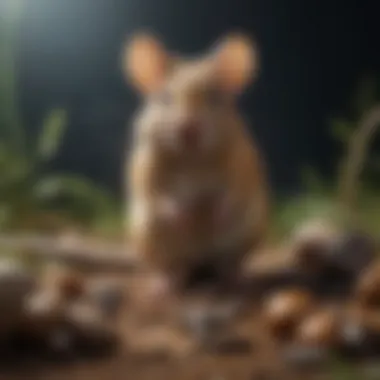
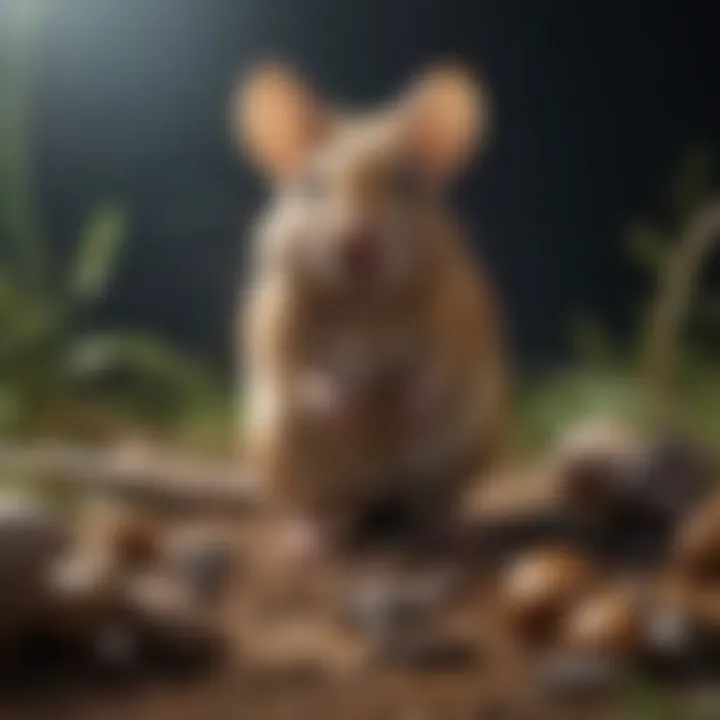
Intro
The Rodentia family is one of the most diverse groups of mammals on Earth. These creatures, often perceived as pests or pets, play essential roles in ecosystems. Rodents, with their distinctive characteristics and behaviors, serve as a fascinating study in biodiversity. In this article, we will navigate through various aspects of this family, from pet characteristics to their ecological impacts. Understanding these animals enhances not only our appreciation for them but also informs responsible ownership and conservation efforts.
Understanding Your Pet
Breed Traits
Rodents, including hamsters, guinea pigs, and mice, vary widely in their physical traits. For example, hamsters are small and fluffy with cheek pouches for storing food. Guinea pigs are larger, friendly creatures known for their social nature. Understanding specific breed traits helps owners meet their pets' needs effectively.
Common Temperaments
Each rodent species exhibits distinct temperamental traits. For instance, some species may be outgoing and playful, while others tend to be shy. Familiarizing oneself with these temperaments is vital for forming strong bonds with these pets.
Special Needs
Rodents require specific care that differs significantly from other pets. Their housing needs, dietary requirements, and social interactions must be tailored to their species. For instance, some rodents thrive in pairs, while others prefer solitude. Knowing these needs can prevent stress and promote welfare.
Pet Care Essentials
Nutrition and Feeding Guidelines
Proper nutrition is crucial for the health of pet rodents. A balanced diet typically includes fresh vegetables, high-quality pellets, and occasional treats. Each type of rodent has specific dietary needs; for example, rabbits need high fiber, while hamsters can have varied diets.
Grooming Tips and Techniques
Grooming enhances the well-being of pet rodents. Species like long-haired guinea pigs require regular brushing, while others benefit from periodic nail trimming. Maintaining hygiene reduces health risks and promotes a conducive living environment.
Health and Wellness
Regular veterinary check-ups are essential for ensuring rodent health. Conditions such as dental disease and obesity are common in rodents. Owners should observe their pets for signs of illness, such as changes in eating habits or lethargy.
Training and Behavior
Basic Training Techniques
Training a pet rodent can be a rewarding experience. Positive reinforcement methods can help teach basic commands and tricks. Simple tasks, like coming when called, can foster communication between the pet and owner.
Behavioral Problems and Solutions
Rodents may display behavioral issues, such as aggression or anxiety. Understanding the root cause of these behaviors is crucial for resolution. Provide enrichment, like tunnels and toys, to help alleviate stress and boredom.
Mental Stimulation Activities
Rodents are intelligent and need mental stimulation. Interactive toys, puzzles, and free-roaming time can enhance their quality of life. Engaging activities help prevent undesirable behaviors that stem from boredom.
Engaging with Your Pet
Interactive Games and Toys
Choosing the right toys is essential for engagement. Rodents enjoy chew toys and climbing equipment. Interactive games stimulate their curiosity and encourage physical activity, which is vital for their health.
Safe Outdoor Activities
Supervised outdoor exploration can benefit rodent health and happiness. Care should be taken to secure the area and prevent escape. A safe space allows for natural behaviors like digging and exploring.
Family-Friendly Pet Interactions
Rodents can be excellent family pets. Teaching children how to interact gently and respectfully promotes healthy relationships between pets and family members. Responsibilities can also foster a sense of care and empathy in young ones.
Pet Adoption and Integration
Choosing the Right Pet for Your Lifestyle
Selecting a pet requires careful consideration of lifestyle and space. Active families may prefer more playful species, while quieter households may opt for more solitary rodents. Evaluating compatibility ensures a harmonious home environment.
Preparing Your Home for a New Pet
Creating a welcoming space for a new rodent involves providing proper housing, bedding, and toys. A clean, comfortable environment helps reduce stress and aids in a successful transition.
Tips for Smooth Intro
When introducing a new pet to the household, patience is essential. Gradually allow the pet to explore its new home while respecting its need for space. Observing their behavior offers insights into their adjustment.
Foreword to Rodentia
Rodents are a fascinating group of mammals that play significant roles in their ecosystems and in human life. Understanding Rodentia allows us to appreciate the various species' unique characteristics and their conscious and subconscious influence on our environment. This section serves as a foundation for exploring the topic's complexities and highlights why examining these creatures is essential for pet owners and enthusiasts alike.
Defining Rodentia


Rodentia is an order of mammals known as rodents, characterized by a single pair of continuously growing incisors in both their upper and lower jaws. To maintain these incisors' length, rodents must constantly gnaw on various materials, such as wood, seeds, and plants. This constant gnawing not only differentiates them from other mammals but also contributes to their adaptability in diverse habitats.
Rodents are incredibly diverse, comprising over 2,000 species, which makes them the largest order of mammals by species count. This extensive variation encompasses familiar animals like the House Mouse and the Guinea Pig, as well as more exotic species like the Capybara and the Spiny Mouse. Their ability to thrive in various environments, from forests to urban areas, exemplifies their versatility and resilience.
Evolutionary Background
The evolutionary history of rodents dates back to the late Paleocene, approximately 66 million years ago. They diversified rapidly during the Eocene epoch, leading to the emergence of various families and species. This rapid evolution is believed to be linked to their ecological versatility, which allowed them to adapt to changing climates and habitats over millions of years.
Some key points in rodent evolution include:
- Origin: Rodents likely evolved from a common ancestor shared with other mammalian orders, such as the primates and bats.
- Adaptations: They have developed various traits like burrowing and climbing abilities, which are crucial for survival in diverse habitats.
- Domestication: Certain species, like the rat and Guinea Pig, have been domesticated by humans for companionship and research, leading to an increased understanding of their behavior and biology.
Understanding the evolutionary background of rodents sheds light on their adaptive strategies and their significant role within ecosystems.
Classification of Rodents
Understanding the classification of rodents is crucial for several reasons. Firstly, it gives insight into the vast diversity within the family Rodentia. This family contains a wide array of species, each adapted to their specific environment. Knowing their classification helps in understanding these adaptations and their ecological roles. Furthermore, classification aids in conservation efforts. By identifying different families and species, we can better allocate resources and make informed decisions in managing their populations.
Order and Families
Rodentia is divided into several families, each exhibiting unique characteristics. The primary families include Muridae, Caviidae, and Sciuridae.
- Muridae: Known as the mouse family, this is the largest family among rodents, containing species like house mice and rats. They are highly adaptable and found in varied environments.
- Caviidae: This family includes guinea pigs and capybaras, noted for their sociable nature and specific dietary habits.
- Sciuridae: This family encompasses squirrels, which are often found in both urban and forested areas and are known for their climbing abilities and bushy tails.
Each of these families can be further divided into genera and species, illustrating the incredible breadth of rodent diversity.
Key Features of Rodentia
Rodents share several key features that distinguish them from other mammals. Their most defining characteristic is their continuously growing incisors. These teeth require constant gnawing to maintain a manageable length, which leads to their diets largely consisting of seeds, nuts, and plants.
In addition to dental adaptations, rodents are generally small to medium-sized. Their body structure allows them to be agile and efficient at foraging. They have strong hind limbs that facilitate quick movements, either for fleeing predators or for accessing food. Social behavior varies across species; some are solitary while others live in large groups, showcasing the adaptability and range of social structures within the order.
Another significant element is their reproductive rate. Many rodents can reproduce several times a year, resulting in high population growth under favorable conditions, which is important for their survival in various ecosystems. In summary, the classification of rodents provides essential knowledge about their biological traits, behaviors, and roles in both nature and human society.
Diversity Among Rodents
The diversity within the Rodentia family is crucial for understanding the broader implications of this group. Rodents are widespread across various habitats and exhibit a vast range of adaptations that enable them to thrive in diverse environments. This diversity contributes to ecological stability, with different species fulfilling various roles in ecosystems. Each species' unique adaptations highlight the evolutionary processes that shape animal behavior and physiology.
Common Species
House Mouse
The House Mouse is a notable species often encountered in urban settings. Its adaptability makes it a popular choice for research and as a pet. The House Mouse is small and has a quick reproduction cycle, which helps maintain its population despite predation and environmental challenges. One unique feature is its strong olfactory senses, which it uses for communication and finding food. However, this can lead to issues in homes, as they often cause damage when seeking food.
Norway Rat
The Norway Rat is another essential species in the Rodentia family. It is larger than the House Mouse and is known for its intelligence and adaptability. This rat can thrive in various conditions, making it a common pest in urban areas. Its ability to reproduce quickly also contributes to its success. A defining characteristic of the Norway Rat is its strong social ties; they often live in colonies and develop complex social structures. Unfortunately, they can pose health risks as carriers of disease, which poses a challenge for urban management practices.
Guinea Pig
Guinea Pigs are domesticated rodents valued for their amiable disposition. They are popular pets, particularly among families with children due to their gentle nature. A significant aspect is their social behavior; they thrive in pairs or groups, which fosters a lively environment. Guinea Pigs do not require extensive space, making them suitable for smaller living conditions. However, their specific dietary needs can be a disadvantage for novice pet owners, as they require fresh vegetables and hay for optimal health.
Capybara
The Capybara, often referred to as the world's largest rodent, is an intriguing species that thrives in semi-aquatic environments. Their social behavior is remarkable, often seen in groups that can include up to 20 individuals. Capybaras have a unique feature; their webbed feet allow them to swim efficiently, aiding their survival in the wild. While they can be kept as exotic pets, their size and specific habitat needs pose significant challenges for potential owners. Understanding these unique characteristics is important for anyone considering keeping a Capybara as a pet.
Rare and Exotic Rodents
Spiny Mouse
The Spiny Mouse is an unusual but fascinating species worth noting. Recognizable for its spiny fur, it is predominantly found in arid regions. This adaptation protects them from predators and harsh weather. The Spiny Mouse is known for having nocturnal behavior, which allows it to avoid daytime heat. While it's not a common pet, its unique appearance captures the interest of some enthusiasts. However, their specialized habitat needs often limit their keeping in a domestic setting.
Tuco-Tuco
Tuco-Tucos are burrowing rodents found mainly in South America. They are unique in their subterranean lifestyle. The Tuco-Tuco displays a strong territorial instinct, marking their tunnels and defending them aggressively against intruders. Their adaptation to a burrowing life limits their visibility to the general public. People interested in these rodents must be aware of their specific habitat requirements and behaviors. Keeping Tuco-Tucos can be challenging due to their complex social structures and tunneling habits.
African Pygmy Mouse
The African Pygmy Mouse is one of the smallest rodents in the world. Its tiny size allows it to navigate its environment and evade predators effectively, making it a resilient species. These mice are social, often living in colonies, which leads to complex group dynamics. While they are fascinating creatures, their delicate nature makes them less suited for inexperienced pet owners. They require careful handling, and suitable living conditions are essential for their well-being.
Habitat and Distribution
Understanding the habitat and distribution of rodents is crucial for comprehending their behavior, adaptability, and ecological significance. This section examines how rodents occupy different ecosystems and how these environments shape their lifestyles. Their ability to thrive in varied habitats directly influences their interactions with other species, including humans.
Global Distribution
Rodents exhibit a remarkable global distribution. They inhabit every continent except Antarctica. This wide dispersal is a direct result of their adaptable nature. Rodents can be found in numerous biomes, ranging from tropical forests to temperate grasslands. Their adaptability to various climates and environments underscores their evolutionary success. Certain species, like the house mouse, have even managed to thrive in urban settings worldwide.
Preferred Habitats
Urban Areas
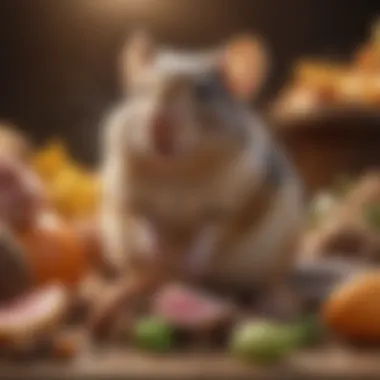
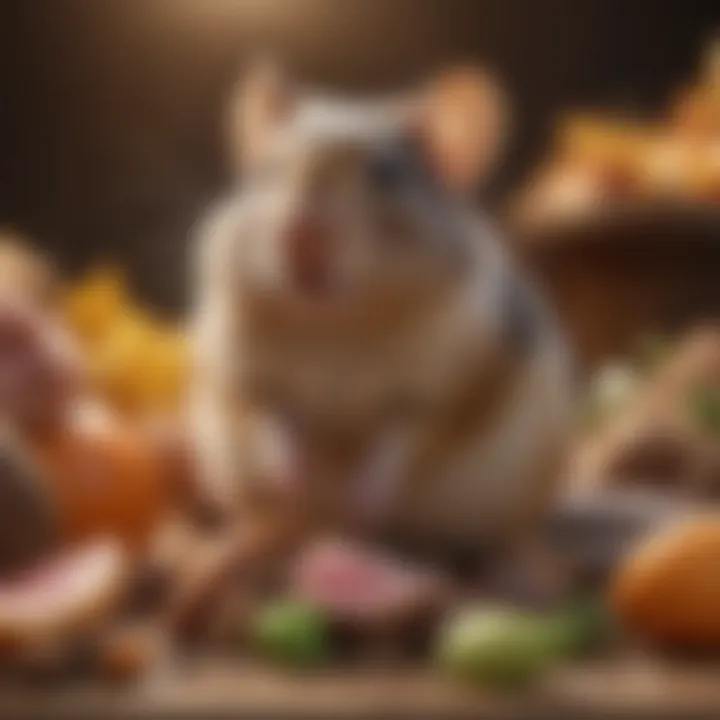
Urban areas present a unique habitat for rodents. Many species, like the brown rat, find food and shelter in these densely populated spaces. The key characteristic of urban environments is the abundance of human refuse, which provides a constant food source. This makes urban spaces a beneficial choice for many rodents. However, living alongside humans can lead to conflicts, especially when rodents invade homes .
Forests
Forests serve as an essential habitat for various rodent species. Trees offer shelter, nesting sites, and diverse food sources such as seeds and fruits. The key feature of forests is their layered structure, which supports different species in varying niches. This habitat is advantageous for the myriad species that depend on its resources. Yet, deforestation poses a significant threat to rodents that rely on forest ecosystems.
Grasslands
Grasslands are another crucial habitat for rodents. They provide open spaces that allow burrowing species to thrive. The primary characteristic here is the availability of grasses and underground tunnels, aiding survival. Grasslands are popular habitats for many species, such as prairie dogs, which maintain complex social structures. However, these environments are vulnerable to agricultural expansion and habitat loss.
Deserts
Deserts, though challenging, are also home to various rodent species like kangaroo rats. Rodents adapted to these harsh conditions have developed unique behaviors to conserve water. The key aspect of desert habitats is their extreme conditions, with fluctuating temperatures and scarce food. This makes desert rodents resilient but also exposes them to risks, such as climate change and habitat degradation.
The adaptability of rodents to various habitats highlights their ecological importance and influence on their environments.
Rodent Behavior
Understanding rodent behavior is fundamental in comprehending the broader scope of the Rodentia family. These behaviors give insights into how various species adapt to their environments, interact with each other, and coexist with humans. The analysis will also reveal implications for pet owners and conservation efforts.
Feeding Habits
Feeding habits encompass the dietary preferences and foraging techniques of rodent species. These two components illustrate how rodents survive and thrive in diverse ecosystems.
Dietary Preferences
The dietary preferences of rodents are remarkably diverse. Rodents are primarily herbivorous, favoring seeds, nuts, fruits, and vegetation. This herbivory is crucial for their survival and ecological contributions.
Rodents like guinea pigs need a high-fiber diet, which points to the significance of hay and fresh vegetables. Such preferences not only satisfy their nutritional needs but also support digestive health. The most remarkable feature of dietary preferences among rodents is their continuous growth of incisors, which necessitates regular gnawing. This feature can be beneficial, as it drives the necessity for various diets across species, but it can present challenges if the wrong food is offered, potentially leading to health issues.
Foraging Techniques
Foraging techniques are essential for the survival of rodents. These methods refer to how rodents acquire food sources in their environments. Scatter hoarding and active foraging are two prominent techniques observed. Scatter hoarding, observed in some species like the squirrel, involves hiding food in multiple locations, thus ensuring a food supply during scarcity. This is a beneficial choice for rodents as it enhances their chances of staying nourished efficiently.
A unique feature of foraging techniques is the adaptability shown by species. Some rodents are known for clever methods of pilfering from others. While this behavior can be advantageous in the short term, it also opens them up to competition and conflict with others.
Social Structure
Rodent social structures vary extensively across species. Understanding these dynamics helps in recognizing the behavioral traits that can be significant in the pet community and wildlife.
Solitary vs Social Species
Rodents exhibit a range of social structures. Some, like the house mouse, are very social. They live in groups and have a complex social hierarchy. This social structure exhibits cooperation in foraging and nesting. In contrast, species like the woodchuck tend to be solitary, preferring to live alone foraging and nesting. This divergence is beneficial, creating varied social dynamics and strategies for survival. The unique feature of social behaviors is that social species often have better success in navigating threats together, which can be a deciding advantage in the wild.
Territorial Behavior
Territorial behavior is prevalent in many rodent species, impacting their interactions both with each other and their habitats. Species like the Norway rat often display fierce territorial tendencies, which safeguard resources and breeding locations. This behavior is critical as it ensures reproductive success and resource allocation.
Furthermore, territorial rodents often engage in scent-marking. This feature serves not only as a communication tool but also as a deterrent against intruders. While beneficial in maintaining territory, aggressive territoriality can lead to conflicts, driving population control challenges especially in urban areas.
Understanding rodent behavior is essential for pet owners. It aids in creating environments that cater to the natural instincts and needs of these animals.
Reproduction and Lifespan
The reproduction and lifespan of rodents are vital topics within the study of the Rodentia family. Understanding these aspects provides insights into their biology, ecology, and their interactions with humans. Rodents reproduce quickly, which allows them to adapt to changing environments and population pressures. Their lifespan can vary widely among different species, influencing their behavior and social structures. This section examines breeding patterns and growth stages to highlight the significance of these factors in the overall understanding of rodents.
Breeding Patterns
Rodents exhibit diverse breeding patterns, often influenced by environmental conditions. Most rodents are known for their high reproductive rates. For example, house mice can breed as early as six weeks old and may produce several litters each year. This leads to rapid population growth under favorable conditions.
Some key aspects of rodent breeding patterns include:
- Mating Systems: Rodents may have monogamous, polygamous, or promiscuous mating systems. For instance, Norway rats tend to be more promiscuous, while guinea pigs often form stable pair bonds.
- Breeding Seasons: Depending on the habitat, some rodent species have distinct mating seasons. In warmer climates, breeding may occur year-round, while in colder areas, it may be restricted to spring and summer.
- Gestation Periods: Gestation varies significantly among species. Most small rodents have shorter gestation periods, typically ranging from 20 to 35 days. In contrast, larger species such as the capybara can have gestation times up to 150 days.
These breeding patterns affect both the population dynamics of rodent communities and their ecological roles.
Growth Stages
Rodent growth stages involve several phases from birth to adulthood. Each stage plays a crucial role in the rodent's life cycle and affects their survival and adaptation.
The main growth stages typically include:
- Neonate Stage: At birth, rodent young are usually altricial, meaning they are born blind and hairless. They rely heavily on their mothers for warmth and nourishment.
- Juvenile Stage: After a few weeks, they develop fur, open their eyes, and begin exploring their surroundings. This is a critical time for learning survival skills.
- Subadult Stage: As they approach maturity, they start to exhibit adult behaviors and sexual characteristics. This transition period is important for social learning.
- Adult Stage: Once fully matured, rodents reach their peak reproductive and survival capabilities.
Growth stages influence not just individual survival but also population dynamics. A rapid transition from juvenile to adult allows for swift population recovery in rodent species.
Understanding rodent reproduction and lifespan is essential for pet owners and those involved in conservation efforts. Awareness of these factors can enhance management strategies and foster a deeper appreciation for these animals.
In summary, the breeding patterns and growth stages of rodents are crucial for comprehending their ecological roles and interactions with humans. This knowledge is beneficial for pet enthusiasts, prospective adopters, and anyone interested in the world of Rodentia.
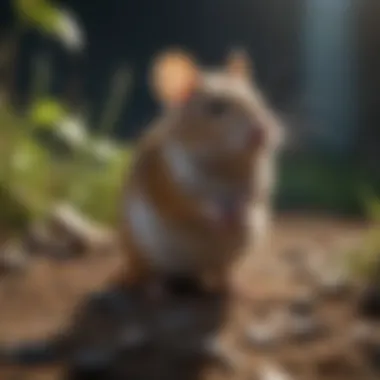
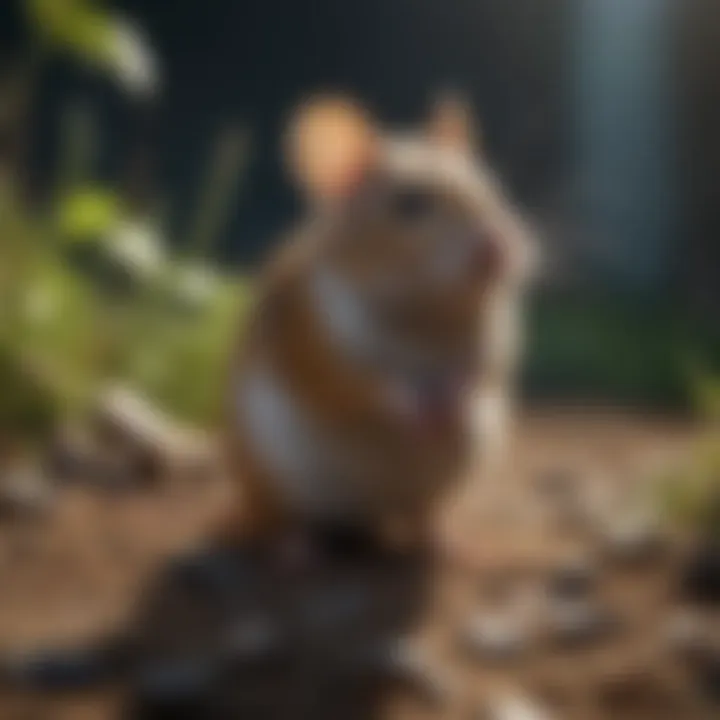
Ecological Roles of Rodents
Rodents play a vital role in maintaining ecosystem health. Their contributions impact not only their immediate habitats but also wider environmental processes. Understanding their ecological functions provides insights into their significance beyond mere nuisance or companionship.
Impact on Ecosystems
Rodents influence ecosystems in various ways. They serve as prey for numerous predators, helping to sustain wildlife populations. This predator-prey relationship is crucial in maintaining ecological balance. Additionally, rodents are essential for nutrient cycling. As they feed on seeds, fruits, and plants, they break down organic material and return nutrients back to the soil through their droppings. This process enhances soil fertility and supports plant growth.
Moreover, rodents aid in the dispersal of seeds. Many species consume seeds and then transport them to other areas. Some seeds are later excreted in different locations, which can lead to germination and the establishment of new plants. This function is vital for forest regeneration and biodiversity.
Seed Dispersal and Soil Health
Rodents are often called the "gardeners of the forest" due to their role in seed dispersal. When rodents eat fruits and seeds, they sometimes forget where they buried or cached these food sources. This behavior inadvertently contributes to new plant growth in various locations, promoting diversity in plant species.
Moreover, their activities in the soil enhance its health. As they dig and burrow, rodents aerate the soil. This aeration improves water infiltration and root penetration, which are essential for plant health. Healthy soil supports a diverse range of organisms, further enriching the ecosystem.
"Rodents enrich ecosystems through their feeding and burrowing habits, making them indispensable to the health of their environments."
In summary, recognizing the ecological roles of rodents helps emphasize their importance. They are not only a part of the natural world but also essential players in the maintenance and health of ecosystems.
Rodents and Human Interaction
Understanding the interaction between rodents and humans is critical, given the multifaceted relationship that has evolved over time. Rodents are often seen through dual lenses— as pests in agriculture and cherished pets. This section unpacks both dimensions, illustrating the complexity and importance of this topic in our lives.
Pests and Agriculture
Rodents have a long-standing reputation as agricultural pests. They can cause substantial damage to crops and stored food supplies, leading to significant economic losses. Common species like the Norway rat and the house mouse are notorious for infiltrating farms and granaries, where they consume grains and vegetables.
Their impact is not just limited to immediate consumption. Rodents can also spread diseases through their droppings, urine, and bites. This poses a substantial health risk to farmers and their communities. Addressing rodent infestations requires a strategic approach that balances control methods with ecological considerations.
Here are some impacts of rodents on agriculture:
- Crop Damage: Direct consumption of plants and seeds.
- Food Contamination: Spoilage due to droppings and urine.
- Disease Transmission: Risks posed by zoonotic diseases.
Farmers often turn to a variety of control measures. These can range from traditional traps to modern prevention techniques. However, the goal is to manage populations effectively while minimizing harm to the environment.
Companionship and Pets
On the other hand, many species of rodents contribute positively to human life as pets. Animals like guinea pigs and hamsters are popular choices for companionship. They require relatively low maintenance, making them ideal for families, children, and even adults seeking companionship.
Rodents as pets can offer numerous benefits:
- Affordability: They are typically less expensive to care for than larger pets.
- Space Requirements: Rodents need less space, making them suitable for apartment living.
- Ease of Care: Their basic needs are straightforward, providing comfort for first-time pet owners.
Moreover, owning a rodent can be educational, especially for children. Caring for a pet can teach responsibility and nurturing behavior. Socially, pets can foster connections among people, promoting social interaction in sharing tips and experiences associated with pet care.
“Rodents have a unique way of becoming cherished members of the family, often enhancing emotional well-being through companionship.”
Managing Rodent Populations
Methods of Control
Preventive Measures
Preventive measures are fundamental in managing rodent populations effectively. These strategies focus on eliminating conditions that attract rodents to specific areas. Such measures include sealing entry points in buildings, proper food storage, and maintaining clean environments. A key characteristic of preventive measures is their ability to be sustained over time, reducing the need for more drastic control methods.
The unique feature of preventive measures is their proactive nature. By addressing the root causes of rodent infestations, they minimize disturbances to both human life and the rodent community. However, there are some disadvantages. Preventive measures require consistent effort and awareness among individuals and communities. Without diligence, any gains made can be quickly reversed.
Humane Trapping Options
Humane trapping options present an alternative to lethal control methods. This approach allows for the capture and release of rodents, catering to those who prioritize animal welfare. A key characteristic of humane traps is their design, which ensures that rodents are not injured while being caught. This choice is increasingly popular among those studying the Rodentia family and animal enthusiasts who wish to manage populations ethically.
Humane trapping methods have a unique feature: they allow for the monitoring of rodent populations without killing them. This data can provide insights into rodent behaviors and habitats, which is beneficial for scientific research and conservation efforts. Nevertheless, these options come with disadvantages as well. They may require more labor and time than traditional traps, and they also depend on proper knowledge to ensure the safe release of captured animals.
Conservation Efforts
Conservation efforts focus on protecting rodent habitats and promoting biodiversity. These efforts enhance the understanding of rodent roles within ecosystems, fighting habitat loss and encouraging the coexistence of humans and wildlife. Long-term vision is essential for conservation, leading to sustainable practices that benefit both rodent populations and their ecosystems.
Maintaining healthy rodent populations can foster a balanced ecosystem. Thus, education is crucial to ensure that communities understand the importance of conserving not only the rodents but also their habitats. Failing to manage these populations can lead to ecological imbalances, emphasizing the connection between rodent management and conservation.
Ending
Key Elements of the Finale
- Biodiversity Contribution: Rodents enhance biodiversity through their adaptations and varying habitats.
- Ecosystem Engineers: Their burrowing and foraging habits significantly affect soil health and nutrient cycling.
- Human Interactions: The relationship between humans and rodents is complex, encompassing both pest status in agriculture and companionship in domesticated forms.
The conclusion also addresses future research opportunities. Continued study of Rodentia can unlock insights into their evolutionary history, behavior, and potential contributions to science and agriculture. Scientists and pet owners alike benefit from ongoing research, which highlights both the ecological functions and the importance of proper care in domesticated species.
Summary of Key Points
- Rodents are an incredibly diverse group, with over 2,000 species.
- They serve critical roles in ecosystems, including seed dispersal and providing food for predators.
- Understanding their behavior and ecology is vital for effective population management and conservation efforts.
- Their interaction with humans can both be beneficial and problematic, requiring thoughtful approaches to coexistence.
Future of Rodentia Research
Research on Rodentia remains an evolving field. Investigations into their genetics, behavior, and interactions with other species can lead to a deeper understanding of their ecological roles. For example, studying the Capybara's social structures can reveal useful information about the social dynamics of larger rodent species.
Moreover, the impact of rodents on human activities, particularly in agriculture, presents a pressing area of study. Finding humane ways to manage populations while ensuring ecological balance is critical. This balance requires scientists and pet owners to work collaboratively, advancing knowledge while minimizing negative impacts.



